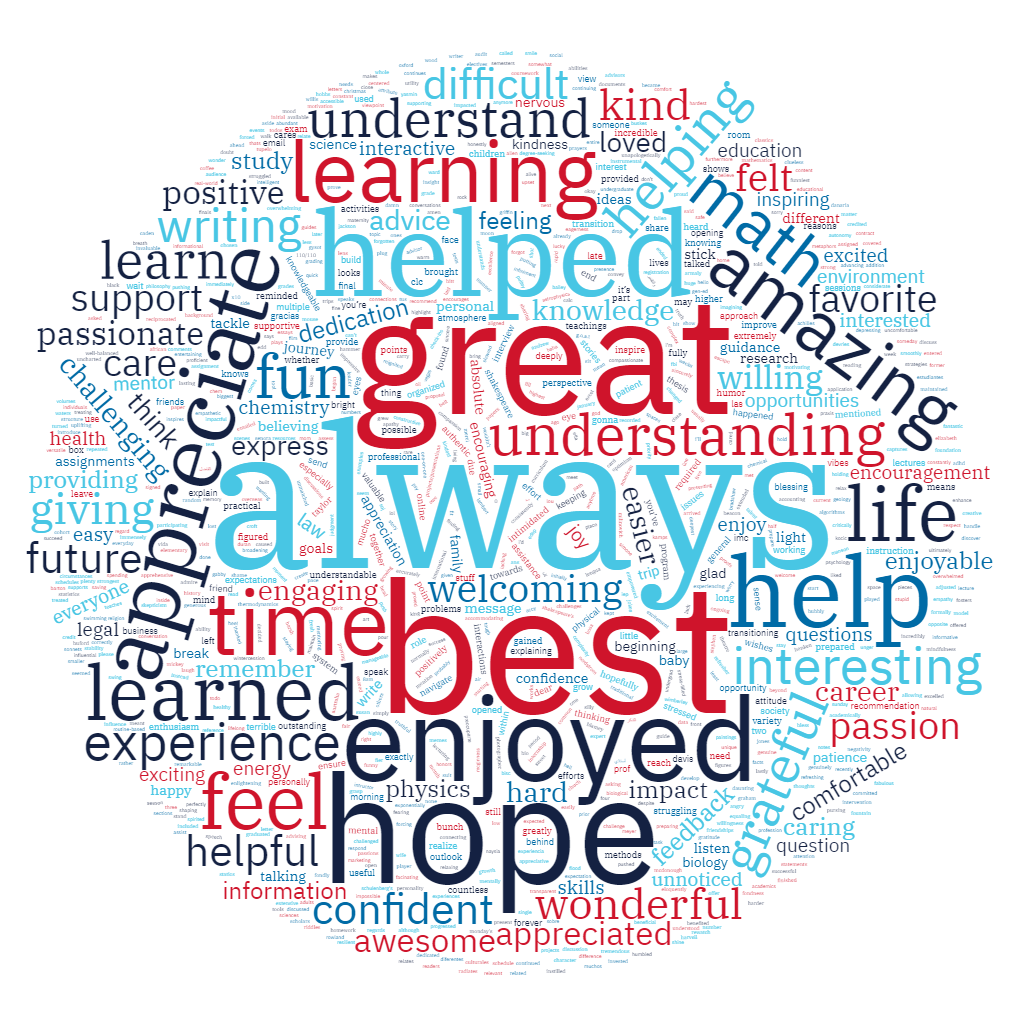Last August, CETL launched its Thank-an-Instructor program. The goals and the methods of the program are simple. We created a form where students can write messages of thanks to instructors whose teaching has really mattered to them. We then pass those messages on to instructors who can read about how their teaching has made a difference in the lives of their students.
Since we launched the program, we have received more than 350 responses from students. We all agree that reading those responses, and passing them along, is one of the most joyful parts of our work here at CETL.
To get a sense of what students most appreciate about UM instructors, we used their responses to make a word cloud, which displays the most prominent words found in students’ messages of thanks. Each of us at CETL picked a word we found interesting or surprising and wrote a short paragraph on what it says about our teachers. Here are our reflections:
Appreciate / Liz Norell
Researchers tell us that gratitude is a practice that boosts happiness, so seeing the word “appreciate” feels especially…well, gratifying! Too often, instructors can feel like they’re teaching into a void, not knowing whether the effort they put into their teaching is paying off in student learning. Hearing that a student appreciates your efforts can make an instructor’s day! Imagine, then, if students also heard from us how much we appreciate their efforts, conscientiousness, or presence. The CETL team would love to see the Thank an Instructor program generate a waterfall of expressions of gratitude. What do you appreciate about your students? Consider telling them!
Welcoming / Derek Bruff
“Welcoming” stood out to me in this word cloud. I recently talked with Isis Artze-Vega, co-author of Connections Are Everything: A College Student’s Guide to Relationship-Rich Education, on my podcast, and she said that students walk into all of our classes silently asking questions of us like “Who are you? Why are you here? What do you know about me? How do you see yourself in relation to me?” Instructors who create a welcoming learning environment, especially on the first day, are building students’ trust in them, and that goes such a long way toward helping those students learn and succeed in our courses.
Understand(ing) / Emily Donahoe
I was struck by the permutations of the word “understand” in these responses, since “understanding” is key to teaching in several ways. To state the obvious, cultivating student “understanding” is our purpose as instructors. But several students also noted that their instructors were “understanding”—i.e., sympathetic or compassionate—in ways that ultimately helped cultivate students’ academic “understanding.” We know from the research that feeling seen and understood not only enhances wellbeing but can also promote transformative learning.
Moreover, if you take a dive into the etymology of the word “understand” (bear with me, I’m an English major), you’ll find that the earliest versions of the word actually meant “to stand between.” And that’s what teachers do, really: they stand in the gap between what students know and what they don’t know, between who they are today and who they are tomorrow. The classroom provides space for all of us to bridge those gaps and come to greater understandings of ourselves, each other, and the world around us. I’m glad that students both cultivated their own understandings and felt understood through their encounters with UM instructors.
Baby / Hanna Lee
Nestled right after the s in “best,” and surrounded by so many other obviously relevant words is “baby.” It’s bigger than some other words, which means it occurred more than multiple times. What is it doing here? Students used this word in two different contexts. Some students talked about hoping to make instructors proud when they eventually become "baby" professionals. Other students talked about actual babies—instructors’ babies and students’ babies. The work that the best instructors do extends beyond class time, and beyond the classroom. These “babies” remind us of the profound ways that great teachers impact and affirm their students as people, inside and outside of the classroom, now and in the future.
Life / Hannah Margaret Glass
Seeing “life” in this cloud brings to mind a quote from poet Philip Appleman: “Whatever we are, whatever we make of ourselves, is all we will ever have—and that, in its profound simplicity, is the meaning of life.” As CETL’s Supplemental Instruction Program Supervisor, I work with diligent, high-achieving students; these students and their classmates are highly aware that their time in college is what they make of it. They work incredibly hard to stand out from their peers, to be involved in a variety of extracurriculars and organizations in order to become successful applicants for graduate and professional programs. Each semester, I hear how much UM faculty are impacting the choices that students are making about their future. Their instructors are passionate about the subjects they teach and about the success of their students both in and out of the classroom. They encourage their students to apply to different programs and scholarships, to participate in research, and to think about their future careers in a more calculated manner. Students want instructors to know how much more they are able to make of their lives because of faculty members’ invested efforts.
Hope / Josh Eyler
Seeing “hope” so prominently displayed in this graphic is the sort of thing that makes our hearts leap with joy in CETL. Kevin Gannon, the director of the teaching center at Queens University of Charlotte, calls education an act of “radical hope,” especially during times of uncertainty. Helping students to see possibilities, to cultivate lives and careers that are meaningful to them, to understand ideas in a new way—these are all hopeful acts, and it is clear that students are finding this hope in their interactions with UM faculty.









